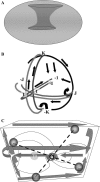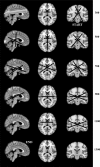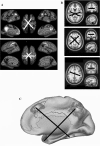Towards a fourth spatial dimension of brain activity
- PMID: 27275375
- PMCID: PMC4870410
- DOI: 10.1007/s11571-016-9379-z
Towards a fourth spatial dimension of brain activity
Abstract
Current advances in neurosciences deal with the functional architecture of the central nervous system, paving the way for general theories that improve our understanding of brain activity. From topology, a strong concept comes into play in understanding brain functions, namely, the 4D space of a "hypersphere's torus", undetectable by observers living in a 3D world. The torus may be compared with a video game with biplanes in aerial combat: when a biplane flies off one edge of gaming display, it does not crash but rather it comes back from the opposite edge of the screen. Our thoughts exhibit similar behaviour, i.e. the unique ability to connect past, present and future events in a single, coherent picture as if we were allowed to watch the three screens of past-present-future "glued" together in a mental kaleidoscope. Here we hypothesize that brain functions are embedded in a imperceptible fourth spatial dimension and propose a method to empirically assess its presence. Neuroimaging fMRI series can be evaluated, looking for the topological hallmark of the presence of a fourth dimension. Indeed, there is a typical feature which reveal the existence of a functional hypersphere: the simultaneous activation of areas opposite each other on the 3D cortical surface. Our suggestion-substantiated by recent findings-that brain activity takes place on a closed, donut-like trajectory helps to solve long-standing mysteries concerning our psychological activities, such as mind-wandering, memory retrieval, consciousness and dreaming state.
Keywords: Borsuk-Ulam theorem; Brain; Central nervous system; Fourth dimension; Hypersphere; Manifold.
Figures





References
-
- Afraimovich V, Tristan I, Varona P, Rabinovich M. Transient dynamics in complex systems: heteroclinic sequences with multidimensional unstable manifolds. Discontin Nonlinearity Complex. 2013;2(1):21–41. doi: 10.5890/DNC.2012.11.001. - DOI
Publication types
LinkOut - more resources
Full Text Sources
Other Literature Sources
Miscellaneous

